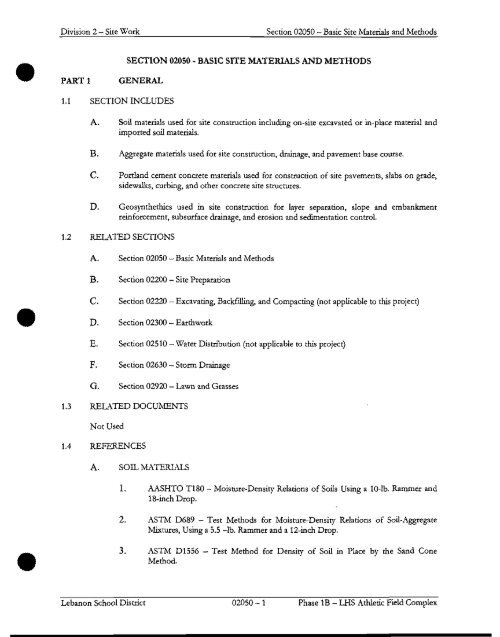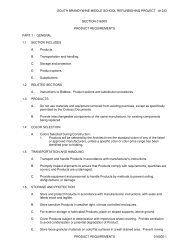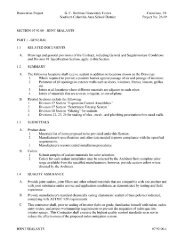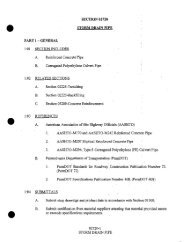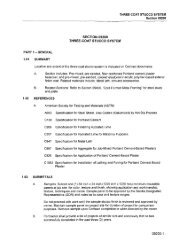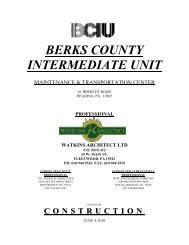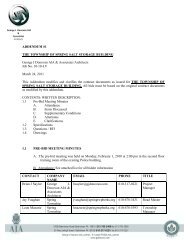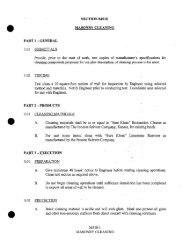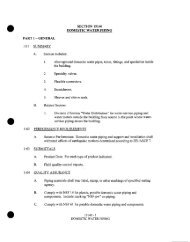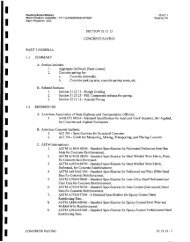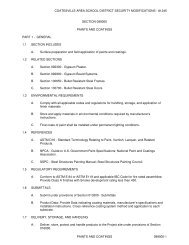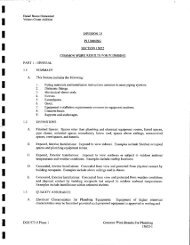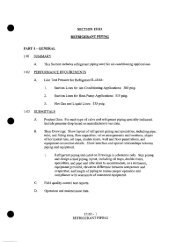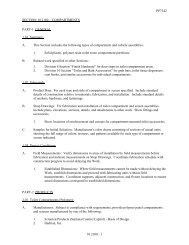section 02050 - basic site materials and methods part 1 general
section 02050 - basic site materials and methods part 1 general
section 02050 - basic site materials and methods part 1 general
You also want an ePaper? Increase the reach of your titles
YUMPU automatically turns print PDFs into web optimized ePapers that Google loves.
Division 2 - Site Work<br />
Section <strong>02050</strong> - Basic Site Materials <strong>and</strong> Methods<br />
SECTION <strong>02050</strong> - BASIC SITE MATERIALS AND METHODS<br />
PART 1<br />
GENERAL<br />
1.1 SECTION INCLUDES<br />
A. Soil <strong>materials</strong> used for <strong>site</strong> construction including on-<strong>site</strong> excavated or in-place material <strong>and</strong><br />
imported soil <strong>materials</strong>.<br />
B. Aggregate <strong>materials</strong> used for <strong>site</strong> construction, drainage, <strong>and</strong> pavement base course.<br />
C. Portl<strong>and</strong> cement concrete <strong>materials</strong> used for construction of <strong>site</strong> pavements, slabs on grade,<br />
sidewalks, curbing, <strong>and</strong> other concrete <strong>site</strong> structures.<br />
D. Geosynthethics used in <strong>site</strong> construction for layer separation, slope <strong>and</strong> embankment<br />
reinforcement, subsurface drainage, <strong>and</strong> erosion <strong>and</strong> sedimentation control.<br />
1.2 RELATED SECTIONS<br />
A. Section <strong>02050</strong> - Basic Materials <strong>and</strong> Methods<br />
B. Section 02200 - Site Preparation<br />
C. Section 02220 - Excavating, Backfilling, <strong>and</strong> Compacting (not applicable to this project)<br />
D. Section 02300 - Earthwork<br />
E. Section 02510 - Water Distribution (not applicable to this project)<br />
F. Section 02630 - Storm Drainage<br />
G. Section 02920 — Lawn <strong>and</strong> Grasses<br />
1.3 RELATED DOCUMENTS<br />
Not Used<br />
1.4 REFERENCES<br />
A. SOIL MATERIALS<br />
1. AASHTO T180 - Moisture-Density Relations of Soils Using a 10-lb. Rammer <strong>and</strong><br />
18-inch Drop.<br />
2. ASTM D689 - Test Methods for Moisture-Density Relations of Soil-Aggregate<br />
Mixtures, Using a 5.5 -lb. Rammer <strong>and</strong> a 12-inch Drop.<br />
3. ASTM D1556 - Test Method for Density of Soil in Place by the S<strong>and</strong> Cone<br />
Method.<br />
Lebanon School District <strong>02050</strong> - 1 Phase IB - LHS Athletic Field Complex
Division 2 - Site Work<br />
Section <strong>02050</strong> - Basic Site Materials <strong>and</strong> Methods<br />
4. ASTM D1557 - Test Method for Moisture-Density Relations of Soil-Aggregate<br />
Mixtures Using a 10-lb. Rammer <strong>and</strong> an 18-inch Drop.<br />
5. ASTM D2167 - Test Method for Density <strong>and</strong> Unit Weight of Soil in Place by the<br />
Rubber Balloon Method.<br />
6. ASTM D2487 - Classification of Soils for Engineering Purposes.<br />
7. ASTM D2922 - Test Methods for Density of Soil <strong>and</strong> SOIL Aggregate in Place by<br />
Nuclear Methods (Shallow Depth)<br />
8. ASTM D3017 - Test Method for Moisture Content of Soil <strong>and</strong> Soil Aggregate in<br />
Place by Nuclear Methods (Shallow Depth)<br />
9. ASTM C136 - Sieve Analysis of Fine <strong>and</strong> Coarse Aggregates.<br />
10. ASTM D422 - Particle Size Analysis of Soils.<br />
B. AGGREGATE MATERIALS<br />
1. AASHTO M147 - Materials for Aggregate <strong>and</strong> Soil-Aggregate.<br />
2. AASHTO T180 — Moisture-Density Relations of Soils Using a 10-lb. Rammer <strong>and</strong><br />
18-inch Drop.<br />
3. ASTM C136 — Method for Sieve Analysis of Fine <strong>and</strong> Coarse Aggregates.<br />
4. ASTM D698 — Test Methods for Moisture-Density Relations of Soils <strong>and</strong> Soil-<br />
Aggregate Mixtures Using a 5.5-lb. Rammer <strong>and</strong> a 12-inch Drop.<br />
5. ASTM D1557 - Test Methods for Moisture-Density Relations of Soils <strong>and</strong> Soil-<br />
Aggregate Mixtures Using a 10-lb. Rammer <strong>and</strong> 18-inch Drop.<br />
6. ASTM D2167 - Test Method for Density <strong>and</strong> Unit Weight of Soil in Place by the<br />
Rubber Balloon Method.<br />
7. ASTM D2487 - Classification of Soils for Engineering Purposes.<br />
8. ASTM D 2922 - Test Methods for Density of Soil <strong>and</strong> Soil Aggregate in Place by<br />
Nuclear Methods (Shallow Depth).<br />
9. ASTM D3017 - Test Method for Moisture Content of Soil <strong>and</strong> Soil-Aggregate in<br />
Place by Nuclear Methods (Shallow Depth).<br />
10. ASTM 4318 - Test Method for Liquid Limit, Plastic Limit, <strong>and</strong> Plasticity Index of<br />
Soils.<br />
11. Pennsylvania De<strong>part</strong>ment of Transportation (PADOT) - Specifications Publication<br />
408, latest edition.<br />
Lebanon School District <strong>02050</strong> - 2 Phase IB - LHS Athletic Field Complex
Division 2 — Site Work<br />
Section <strong>02050</strong> - Basic Site Materials <strong>and</strong> Methods<br />
C. BITUMINOUS CONCRETE AND BITUMINOUS MATERIAL<br />
1. Pennsylvania De<strong>part</strong>ment of Transportation (PADOT) Specifications Publication<br />
408, latest edition.<br />
D. PORTLAND CEMENT CONCRETE MATERIAL<br />
1. Pennsylvania De<strong>part</strong>ment of Transportation (PADOT) Specifications Publication<br />
408, latest edition.<br />
E. GEOSYNTHETIC MATERIAL<br />
1. ASTM D751 - St<strong>and</strong>ard Test Method for Coated Fabrics.<br />
2. ASTM D4491 - St<strong>and</strong>ard Test Methods for Water Permeability of Geotextiles by<br />
Permittivity.<br />
3. ASTM D4595 - Tensile Properties of Geotextiles by the Wide-Width Strip Method.<br />
4. ASTM D4632 — St<strong>and</strong>ard Test Method for Grab Breaking Load <strong>and</strong> Elongation of<br />
Geotextiles.<br />
F. JOINT MATERIALS AND JOINT SEALANTS<br />
1. ASTM C920 — St<strong>and</strong>ard Specification for Elastomeric Joint Sealants.<br />
2. ASTM D1751 - St<strong>and</strong>ard Specification for Preformed Expansion Joint Filler for<br />
Concrete Paving <strong>and</strong> Structural Construction (Nonextruding <strong>and</strong> Resilient<br />
Bituminous Types)<br />
3. ASTM D1752 - St<strong>and</strong>ard Specification for Preformed Sponge Rubber <strong>and</strong> Cork<br />
Expansion Joint Fillers for Concrete Paving <strong>and</strong> Structural Construction, Sections<br />
5.1 through 5.4 with the compression requirement modified to 10 psi minimum <strong>and</strong><br />
25 psi maximum.<br />
1.5 SUBMITTALS FOR REVIEW<br />
A. Section 01330 — Submittals: Review Procedures for Submittals.<br />
B. Geosynthetic Material Submittals:<br />
1. Where the Contractor proposes to substitute geosynthetic <strong>materials</strong> different from those<br />
shown on plans, the contractor shall submit representative samples of all geosynthetic<br />
proposed for use, including manufacturer's name, designation, <strong>and</strong> installation instructions.<br />
2. Submit detailed drawings, as prepared by the manufacturer, or Contractor, indicating the<br />
method of overlapping, joining, <strong>and</strong> anchoring of geosynthetic <strong>materials</strong> for each<br />
application.<br />
Lebanon School District <strong>02050</strong> - 3 Phase IB - LHS Athletic Field Complex
Division 2 - Site Work<br />
Section <strong>02050</strong> — Basic Site Materials <strong>and</strong> Methods<br />
1.6 SOURCE QUALITY CONTROL<br />
A. The Contractor shall notify the Engineer prior to delivery of off-<strong>site</strong> borrow <strong>materials</strong> for<br />
use in <strong>site</strong> construction. The Engineer may require testing of the off-<strong>site</strong> soil material. If<br />
requested, the testing laboratory shall furnish both the Engineer <strong>and</strong> Contractor required<br />
copies of the test reports. The reports will be considered as sufficient information to accept<br />
or reject the proposed imported soil <strong>materials</strong>.<br />
B. If the indicated <strong>materials</strong> do not meet specified requirements, change material <strong>and</strong> retest.<br />
C. Provide soil <strong>and</strong> aggregate <strong>materials</strong> of each designation from same source throughout the<br />
Work.<br />
D. Provide aggregate from PADOT approved source based upon latest PADOT Bulletin.<br />
E. Moisture content for any soil or aggregate material to be used for compacted fill in structural<br />
or non-structural areas shall not exceed a range of plus or minus 3.0 percent of optimum<br />
moisture content for that <strong>part</strong>icular material. If the moisture contents fall outside of this<br />
range appropriate aeration or moisture conditioning measures shall be performed by the<br />
Contractor to maintain soil moisture contents within the specified range<br />
PART 2<br />
PRODUCTS<br />
2.1 SOIL MATERIALS<br />
A. Definitions:<br />
1. Structural Fill Zone: Any area scheduled for building construction, slabs on grade,<br />
rigid pavement, flexible pavements, retaining walls, detention basin berms <strong>and</strong><br />
buffer zones. Structural backfill areas include wall backfill, foundation backfill, <strong>and</strong><br />
retaining wall backfill zones. All utility trench backfill is considered as a structural<br />
fill zone.<br />
2. Nonstructural Fill Zone: Any l<strong>and</strong>scape area that is not included within Structural<br />
Fill Zone or the buffer area of the Structural Fill Zone.<br />
3. Buffer Area: Area extending 10-feet beyond the perimeter of any building<br />
foundation line, including any areas of future expansion indicated on the Drawings,<br />
<strong>and</strong> 10-feet beyond the perimeter of all other Structural Fill Zones.<br />
4. Soils: Earth or aggregate material.<br />
B. General Fill: Inorganic on-<strong>site</strong> soils that do not contain rock fragments that can pass a sixinch<br />
mesh screen <strong>and</strong> are of suitable moisture content. To the extent that on-<strong>site</strong> material<br />
meets the requirements, such material may be used for General Fill. Provide Imported Fill<br />
material required to complete the Work due to insufficient quantity of existing on-<strong>site</strong><br />
material or unsuitability of existing on-<strong>site</strong> material.<br />
C. Structural Fill: Inorganic on-<strong>site</strong> soils with a maximum <strong>part</strong>icle size of four inches. To the<br />
extent that on-<strong>site</strong> material meets the requirements, such material may be used for soil<br />
material. Provide Imported Fill material required to complete the Work due to insufficient<br />
quantity of existing on-<strong>site</strong> material or unsuitability of existing on-<strong>site</strong> material.<br />
Lebanon School District <strong>02050</strong> - 4 Phase IB - LHS Athletic Field Complex
Division 2 - Site Work<br />
Section <strong>02050</strong> - Basic Site Materials <strong>and</strong> Methods<br />
D. Imported Fill: Inorganic well-graded <strong>materials</strong> with 100-percent of the soil material passing<br />
a four-inch mesh screen, at least 25-percent passing a two-inch mesh sieve, <strong>and</strong> 10 to 49-<br />
percent passing a 200 mesh sieve. liquid limit shall not exceed 40 with a maximum plasticity<br />
index of 20. Soil material shall classify as SC, SM, SW, GC, GM, or GW according to ASTM<br />
D2487. Clean, friable, <strong>and</strong> highly weathered shall may be utilized only when approved by<br />
the Engineer. Use of slag is not permitted.<br />
E. Rock Fill: On-<strong>site</strong> excavated <strong>and</strong> shot rock fragments not exceeding 24-inches may be used<br />
in zones designated by the Engineer. Rock fill is not permitted within the structural fill<br />
zone, storm water detention or retention basins, or within six-feet of finished grade. Rock<br />
fill <strong>and</strong> placement shall be in accordance with the recommendations of the Engineer.<br />
F. Select Trench Earth Fill: Material used as structural backfill for utility <strong>and</strong> storm sewer<br />
trenches shall be on-<strong>site</strong> or imported, clean earth meeting the requirements of Class II or III<br />
material, GW, GP, SW, SP, GM, GC, SM or SC in accordance with ASTM D2487.<br />
Materials shall have a maximum Plasticity Index of 15 in accordance with ASTM D4318, <strong>and</strong><br />
shall contain no greater than 20% by weight passing a No. 200 U.S. St<strong>and</strong>ard Sieve. Material<br />
shall not contain organic matter <strong>and</strong> shall be free of frozen <strong>materials</strong>, rock or gravel larger<br />
than 2-inches in any dimension.<br />
G. Clay: Material used in constructing low-permeability clay bedding layers or low permeability<br />
embankment cores shall be on-<strong>site</strong>, or imported, clean material classifying as MH, ML, CH<br />
or CL in accordance with ASTM D2487. Clay material shall not contain objectionable<br />
quantities of debris, roots, <strong>and</strong> organic matter <strong>and</strong> shall be free of frozen <strong>materials</strong>, rock,<br />
gravel or coarse fragments larger than 3/8-inch. No less than 70% of the material by weight<br />
shall pass the No. 200 U.S. St<strong>and</strong>ard Sieve, at least 25% of the material shall be less than .005<br />
mm <strong>part</strong>icle size, <strong>and</strong> at least 10 percent of the material shall be less than 0.002 mm <strong>part</strong>icle<br />
size. Clay material shall have a Liquid Limit (LL) between 30 <strong>and</strong> 80 <strong>and</strong> a Plasticity Index<br />
(PI) between 15 <strong>and</strong> 50, as per ASTM 4318. The clay shall be able to be compacted to the<br />
required density specified herein with an associated permeability of lxlO -7 cm/sec or less<br />
according to ASTM D5084.<br />
H. Topsoil: Friable loamy soil (as classified by the U.S. De<strong>part</strong>ment of Agriculture H<strong>and</strong>book<br />
No. 18, Soil Survey Manual); free of subsoil, roots, grass, weeds, stone, <strong>and</strong> foreign matter;<br />
acidity range (pH) of 5.5 to 7.5; containing a minimum of 3 percent <strong>and</strong> a maximum of 10<br />
percent organic matter. No more than 15 percent by weight shall be larger than a No. 10<br />
U.S. St<strong>and</strong>ard Sieve.<br />
a. To the extent that on-<strong>site</strong> material meets the requirements, such material may be used for<br />
soil material. Provide imported topsoil material required to complete the Work due to<br />
insufficient quantity of existing on-<strong>site</strong> material or unsuitability of existing on-<strong>site</strong> material.<br />
I. All imported soil <strong>materials</strong> must be recovered from approved borrow sources.<br />
2.2 AGGREGATE MATERIALS<br />
A. Aggregate material used in <strong>site</strong> construction shall meet the requirements of PADOT Publication<br />
408, latest edition, Section 703.2, Table C<br />
Lebanon School District <strong>02050</strong> - 5 Phase IB - LHS Athletic Field Complex
Division 2 - Site Work<br />
Section <strong>02050</strong> - Basic Site Materials <strong>and</strong> Methods<br />
B. Aggregate backfill <strong>and</strong> base material shall be a dense-graded mixture of natural or crushed gravel<br />
or crushed stone <strong>and</strong> drainage aggregate material shall be a open-graded mixture of crushed<br />
gravel, crushed stone, or crushed slag meeting the following requirements:<br />
Designation Primary Use AASHTO or<br />
PADOT Number<br />
A-l Flexible Pavement Base Course PA DOT 2A<br />
A-2 Stone Paving PA DOT 2A<br />
A-3 Pipe Bedding (
Division 2 - Site Work<br />
Section <strong>02050</strong> - Basic Site Materials <strong>and</strong> Methods<br />
A Anti-Seep Collars <strong>and</strong> Pipe Anchors 3,000<br />
A Fence, Sign Post, Play Equipment Footers f 3,000<br />
B. Concrete Sealants: As specified in Section 02750.<br />
2.5 GEOSYNTHETIC MATERIAL<br />
A. Geotextiles:<br />
1. Erosion Control: Geotextile fabrics for erosion control shall be a machine fabric mat of<br />
straw, coconut fibers, synthetic or other suitable <strong>materials</strong> sewn together with polypropylene<br />
netting. Specification includes both photodegradable thread <strong>and</strong> UV treated threads for<br />
permanent/semi-permanent erosion control blankets. Manufacturer <strong>and</strong> product specified<br />
on the plan drawings shall be considered the minimum st<strong>and</strong>ard for <strong>materials</strong> proposed as<br />
substitutions or equals.<br />
2. Separation/Stabilization Fabric: Geotextile fabrics used in <strong>site</strong> construction to separate<br />
subgrade from aggregate or soil fill courses <strong>and</strong> for subgrade stabilization shall be a<br />
spunbound non-woven geotextile fabric. Specified manufacturer <strong>and</strong> product shall be<br />
considered the minimum st<strong>and</strong>ard for <strong>materials</strong> proposed as substitutions or equals.<br />
Type Manufacturer/Produc Tensile Puncture Permittivity<br />
t<br />
Strength Strength<br />
S-l Typar 3401 145 lbs. 50 lbs. 0.8 -'<br />
sec<br />
S-2<br />
S-3<br />
Tensile Strength per ASTM D4632<br />
Puncture Strength per ASTM D751<br />
Permittivity per ASTM D4491<br />
3. Drainage/Separation: Geotextile fabric used in <strong>site</strong> construction as <strong>part</strong> of subdrainage<br />
systems shall be non-woven, spunbound geotextile fabric. Specified manufacturer <strong>and</strong><br />
product shall be considered the minimum st<strong>and</strong>ard for <strong>materials</strong> proposed as substitutions<br />
or equals.<br />
Type Manufacturer/Produc Tensile Puncture Permittivity<br />
t<br />
Strength Strength<br />
D-l Typar 3401 145 lbs. 50 lbs. 0.8 *o»<br />
D-2<br />
D-3<br />
Tensile Strength per ASTM D4632<br />
Puncture Strength per ASTM D751<br />
Permittivity per ASTM D4491<br />
4. L<strong>and</strong>scaping/Separation: Geotextile fabric used in <strong>site</strong> construction as <strong>part</strong> of l<strong>and</strong>scaping,<br />
underlayment of mulch areas <strong>and</strong> stone or riprap, <strong>and</strong> separation of mulch or wood fiber<br />
surfacing from underlying subgrade or aggregate base courses shall be a non-woven<br />
geotextile fabric. Specified manufacturer <strong>and</strong> product shall be considered the minimum<br />
st<strong>and</strong>ard for alternate <strong>materials</strong>.<br />
Lebanon School District <strong>02050</strong> - 7 Phase IB - LHS Athletic Field Complex
Division 2 - Site Work<br />
Section <strong>02050</strong> - Basic Site Materials <strong>and</strong> Methods<br />
Type Manufacturer/Produc Tensile Puncture Permittivity<br />
t<br />
Strength Strength<br />
L-l Typar 3341 140 lbs. 40 lbs. l.l»ec-l<br />
L-2 Typar 3201 73 lbs. 23 lbs. 2.6-*- s 1<br />
L-3<br />
Tensile Strength per ASTM D4632<br />
Puncture Strength per ASTM D751<br />
Permittivity per ASTM D4491<br />
B. Geocompo<strong>site</strong> Edge Drains: Not Used.<br />
C. Geocompo<strong>site</strong> In-Place Wall Drains: Not Used.<br />
D. Geogrids: Not Used.<br />
2.6 JOINT MATERIAL<br />
A. Joint <strong>materials</strong> used in <strong>site</strong> construction includes premolded expansion joint filler material,<br />
isolation joint filler material, joint backing material, <strong>and</strong> joint sealing material for<br />
expansion/con traction joints in rigid concrete paving <strong>and</strong> curbing.<br />
B. Joint Filler Material:<br />
1. Non-Sealed Joints:<br />
a. Asphalt: Self-sealing blend of asphalts, fibers, <strong>and</strong> mineral fillers formed between<br />
asphalt-saturated liners meeting the requirements of ASTM D994, Sealtight Asphalt<br />
Expansion Joint Filler as supplied by W.R. Meadows, Inc. (800-342-5976), or<br />
approved equal.<br />
b. Fiber: Non-extruding cellular fibers uniformly saturated with asphalt meeting the<br />
requirements of ASTM D1751, Sealtight Fibre Expansion Joint as supplied by W.R.<br />
Meadows, Inc. or approved equal.<br />
2. Sealed Joints:<br />
a. Non-bimminous material of rubber, cork, or foam conforming to ASTM D1752,<br />
Sealtight Ceramar Flexible Foam Expansion Joint Filler as supplied by W.R. Meadows,<br />
Inc., or approved equal.<br />
C. Joint Sealant Material:<br />
1. Concrete Curb Expansion Joint Sealant: Cold applied rubberized, gun grade, single<br />
component sealing compound meeting the requirements of ASTM D 1850 as supplied by<br />
W.R. Meadows, Inc., or approved equal.<br />
2. Concrete Sidewalk, Slab, <strong>and</strong> Curb Expansion Joint Sealant: Two-component, premium<br />
grade, polyurethane-based, elastomeric, self-leveling sealing compound meeting the<br />
requirements of ASTM C920, Type M, Grade P, Class 25. Pouthane, as supplied by W.R.<br />
Meadows, Inc., SikaBex-2c, as supplied by Sika Corporation (610-437-5096), or approved<br />
equal. Provide st<strong>and</strong>ard manufacturer's color chart for selection by Engineer. Provide<br />
Lebanon School District <strong>02050</strong> - 8 Phase IB - LHS Athletic Field Complex
Division 2 - Site Work<br />
Section <strong>02050</strong> - Basic Site Materials <strong>and</strong> Methods<br />
custom colors to match tinted <strong>and</strong> stained concrete paving as selected by Engineer. Color<br />
selection shall be equal to Sika Corporation St<strong>and</strong>ard <strong>and</strong> Designer color selection chart.<br />
3. Exterior Vertical Concrete Expansion Joint Sealant: Two-component, premium grade,<br />
polyurethane-based, non-sag sealing compound meeting the requirements of ASTM C920,<br />
Type M, Grade NS, Class 25, Use NT, as supplied by W.R. Meadows, Inc., Sikaflex-2c, as<br />
supplied by Sika Corporation, or approved equal. Provide st<strong>and</strong>ard manufacturer's color<br />
chart for selection by Engineer. Provide custom colors to match tinted <strong>and</strong> stained concrete<br />
surfaces as selected by Engineer. Color selection shall be equal to Sika Corporation St<strong>and</strong>ard<br />
<strong>and</strong> Designer color selection chart.<br />
4. Concrete Sidewalk, Slab, <strong>and</strong> Curb Control Joint Sealant: Not Used.<br />
D. Accessories:<br />
1. Joint Cleaner: Non-corrosive <strong>and</strong> non-staining compatible with joint filler material as<br />
recommended by manufacturer.<br />
2. Primer: Non-staining as recommended by manufacturer.<br />
3. Joint Backing: Round, closed cell polyethylene foam rod, oversized 30 to 50 percent of joint<br />
width, meeting the requirements of ASTMD1056.<br />
4. Bond Breaker: Pressure sensitive tape recommended by sealant manufacturer.<br />
PART 3<br />
EXECUTION<br />
A. Install products <strong>and</strong> <strong>materials</strong> in accordance with manufacturer's instructions <strong>and</strong> as directed by<br />
Division 2 Specification Sections utilizing <strong>materials</strong> specified in this Section.<br />
B. Stockpile soil <strong>and</strong> aggregate <strong>materials</strong> on <strong>site</strong> at locations approved by the Owner.<br />
1. Stockpile material in sufficient quantities to meet the Project schedule <strong>and</strong> requirements<br />
of the Work.<br />
2. Separate differing <strong>materials</strong> with dividers or stockpile a<strong>part</strong> to prevent mixing.<br />
3. Direct surface water away from stockpile to prevent erosion. Stabilize stockpiles in<br />
accordance with Erosion <strong>and</strong> Sediment Control Plan or as directed by County<br />
Conservation District.<br />
4. Spoil piles shall be ramped <strong>and</strong> rolled with a vibratory roller <strong>and</strong> covered with plastic to<br />
prevent soils from becoming saturated. No consideration will be given to unsuitable<br />
moisture content of soils not protected from weather conditions.<br />
5. Remove surplus stockpiled material from <strong>site</strong> <strong>and</strong> restore to original or design condition.<br />
Final grade to prevent free st<strong>and</strong>ing surface water.<br />
END OF SECTION<br />
Lebanon School District <strong>02050</strong> - 9 Phase IB - LHS Athletic Field Complex


